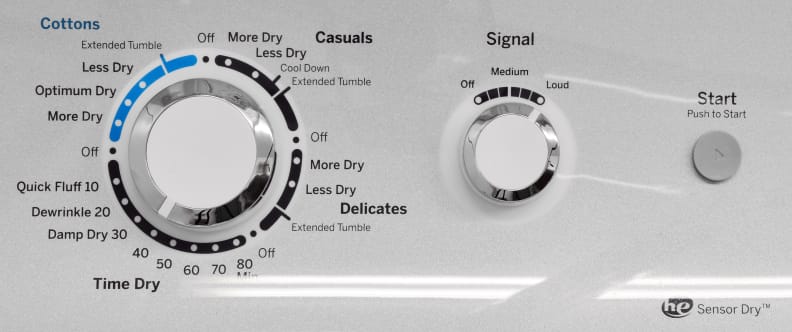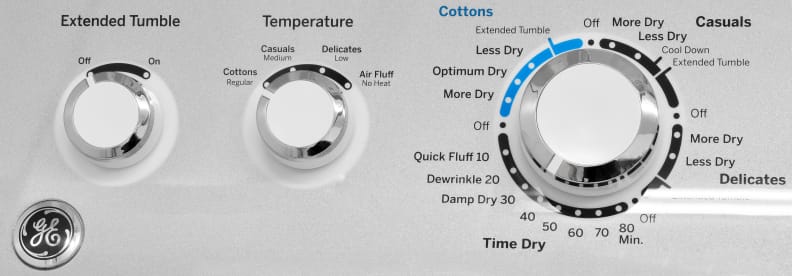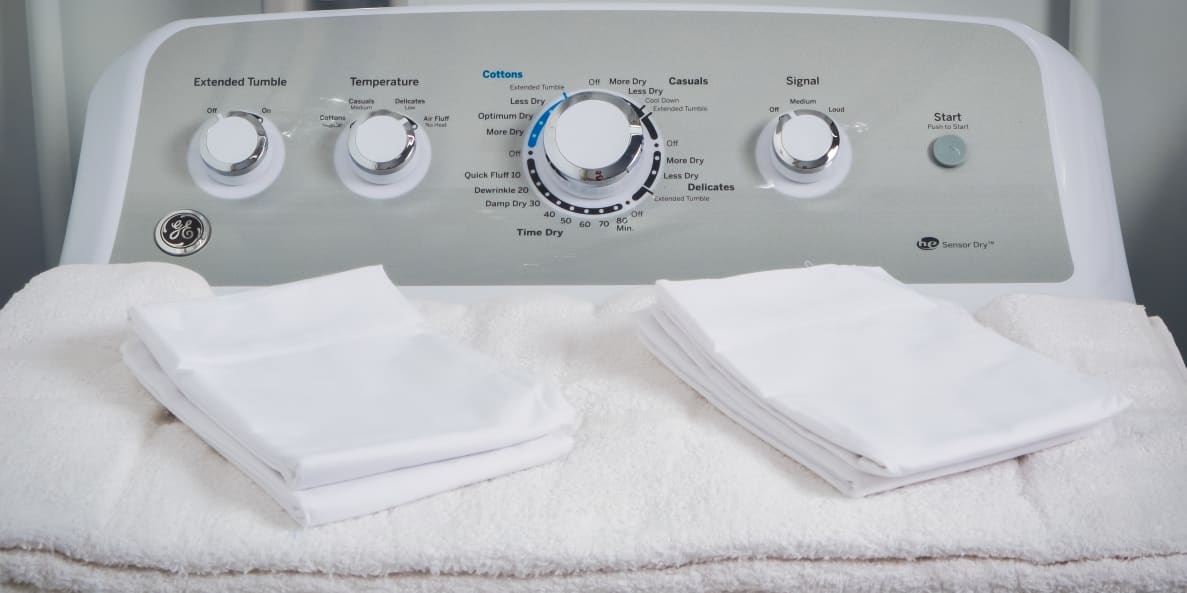Well, one manufacturer is trying to close the cost gap. The GE GTD45EASJWS (MSRP $650) is an electric dryer that comes with high efficiency sensors, and we've found it on sale for only $549. That puts it within striking distance of dryers without that extra tech.
Since your dryer won't be running unnecessarily, that’s good news for your electric bill. In theory, it's also good news for your clothes, as repeated overdrying can destroy fabric. While the GTD45EASJWS outperforms inexpensive sensor-based dryers from Whirlpool, Kenmore and Maytag, our tests also found that it still struggles to get clothes dry enough to wear in one go.
What really keeps us from recommending it wholeheartedly is some internal competition: For just $50 more, we recommend stepping up to the superior GE GTD65EBSJWS.
Design & Usability
A basic layout, with a touch of style
It’s amazing how much a splash of color can add to a white appliance. A gray tint to the control panel gives this otherwise-straightforward GE a hint of personality, as does the bright blue portion of the cycle knob that corresponds to the oft-used Cottons setting.
{{ photo_gallery name="Design" }}
Inside the dryer is something else unique to this GE—the big 7.2-cu.-ft. drum is made out of aluminized alloy. Similar to stainless (though obviously cheaper, given the GTD45’s overall price point), it’s supposed to resist corrosion and other long-term damage. At the very least, it looks pretty snappy, especially with a small incandescent bulb casting a warm yellow glow inside.
On an earlier version of this dryer, we found that the lint trap was a pain in the neck to take out and put back. Based on our complaints—and similar ones from consumers—GE informed us that their engineers redesigned the lint trap on this model. If you have an early version of this dryer and hate the lint trap, GE can provide you a replacement.
Performance & Features
Falters at the last moment
This dryer was doing everything right: Temperatures were suitable for each cycle, drying times were right on average, and then... each cycle came up short in terms of moisture removal.
The Normal cycle took out 95% of excess moisture, which is on the low side of acceptable. (We'll get to that in a minute.) But Delicates only removed 86%—not enough for ironing away, let alone wearing. We found similarly damp results for our Quick Dry and Bulky tests, as well.

This looks like a lot of cycles, but it's really just variations on four different key options.
That’s not to say you need to remove 100% of excess moisture from you laundry, something we learned in our analysis of ventless dryers. But the amount left behind by this GE was simply too much.
If underdrying wasn't so consistent across all cycles, we might've attributed it to the finicky manual control—a design choice that we don't think belongs on modern machines. What looks like an impressive cycle list at first glance is really just three basic options—Cottons, Casuals, and Delicates—with lots of intermediate dryness settings along the way, plus manual Timed Dry. The only other options are Extended Tumble and volume settings for the end-of-cycle chime.
For in-depth performance information, please visit the Science Page.

Four temperature settings and an extended tumble. That's all the control you really have.
Warranty
{{amazon name="Kikkerland Hedgehog Dryer Balls, Reusable, White, Set of 2", asin="B005U9Y71Y", align="right"}} A basic warranty for a basic dryer: If this GE should fail due to a faulty part or defective craftsmanship, parts and labor will be covered in full for one year. This is pretty much the industry standard.
One intallation item of note: Unlike many competitors, all GE's new dryers are designed to work with up to 120 feet of venting.
Worth A Look for the Price
Worth a step up
At $549, the GE GTD45EASJWS outperforms its similarly price competitors. However, we weren't totally impressed with how well it dried clothes. Whether you’re drying clothes efficiently or not, if there’s moisture left over, it’s going to mean extra cycles and more work for you. That’s a no-win situation.
If you like the look and size of the GTD45, consider the next model up. Not only will the GT65 dry your clothes thoroughly, it’s also got a user-friendly interface that feels more at home on a modern appliance. Plus, it’s only $50 more. How can you go wrong?
By the Numbers
At $549 in stores, the sensor-equipped GE GTD45EASJWS ($650) seems like a heck of a bargain. Unfortunately, our tests show this dryer had issues removing moisture from clothes. No matter how efficiently you’re drying, the end result is what matters, and this GE came up short.
Normal & Delicate
For our Normal test, we used the Cottons option set to Optimum Dry and Regular Heat. These settings produced the best results this dryer had to offer: After 1 hour 10 minutes, with temperatures peaking at 151.7°F, our clothes came out 95% dry. Primary cycles like this one should really achieve 98% dryness.
It was all downhill from there. For Delicates, we picked... well, Delicates, set to Less Dry on Low Heat. After a brief 38 minutes, our clothes came out at 86% dry. That’s too damp to wear, and even too damp to iron.
Now, before you ask “why'd you set it to Less Dry?” remember these are the settings we use on every dryer with this kind of control layout. We hold this GE to the same standard as all other machines, and many of those other dryers have done better.

This looks like a lot of cycles, but it's really just variations on four different key options.
Quick Dry & Bulky
Our Quick Dry test almost did well, but fell short. We did a basic 30-minute Timed Dry cycle set to Regular Heat, which produced peak temperatures of 145.3°F and resulted in clothes that were 91% dry. Pretty good for just half an hour, but we've seen speed cycles that last 15-20 minutes and dry just as well.
Finally, our Bulky test saw us return to Cottons and Regular Heat, but this time we set it to More Dry. Our sensors tracked peak temperatures of 146.4°F, and the cycle ran for about 53 minutes on average. It could have used more time, though: Our bulky comforter was only 73% dry at the end of it all.

Four temperature settings and an extended tumble. That's all the control you really have.
Meet the tester
Matthew is a native of Brockton, MA and a graduate of Northeastern, where he earned a degree in English and Theatre. He has also studied at the Gaiety School of Acting in Dublin and spends most of his free time pursuing a performance career in the greater Boston area.
Checking our work.
Our team is here for one purpose: to help you buy the best stuff and love what you own. Our writers, editors, and lab technicians obsess over the products we cover to make sure you're confident and satisfied. Have a different opinion about something we recommend? Email us and we'll compare notes.
Shoot us an email




